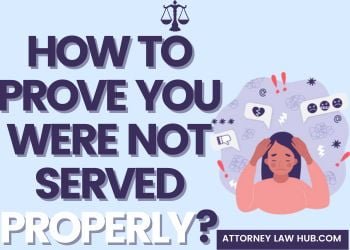It is essential to gather proof and keep records of your interactions in order to prove that you weren’t appropriately received. Start by writing down accurate information about the service engagement, such as the dates, times, and locations
Explain what went wrong in a clear and brief manner, paying particular attention to the elements that fell short of your expectations. To visually document any problems, if at all possible, take pictures or videos. It’s critical to calmly and respectfully express your issues to the service provider while describing the inconsistencies you found. Maintain a record of all communications, including any emails or texts sent and received.
How to Prove You Were Not Served Properly?
If the issue isn’t fixed, you can seek advice from consumer protection organizations or think about taking the matter to court, making sure your case is well-supported by the facts you’ve gathered. As you present your case and argue for the proper treatment you deserve, remember the idea that being broad and organized will help.
Gather evidence to support your case
Here is a step-by-step procedure to help you demonstrate that you were not fairly served:
Create a Situation Report:
Make thorough notes on the conversation, including the occasion’s date, time, place, and participants’ names. Note everything that was said or done that, in your opinion, contributed to poor customer service.
Photographic Evidence:
If necessary, record any problems with the service in photos or films. Visual proof can be exceptionally effective.
Gather Information:
Gather any relevant paperwork, including service contracts, terms of service, and corporate rules that describe the quality of service that is required. Any portions that didn’t match your experience should be highlighted.
Compare with Industry Standards:
Research industry standards and best practises for the kind of service you received before comparing it to them. If the provider’s activities considerably fall short of these expectations, it helps your case.
Request a Detailed description:
Ask the service provider politely for a thorough description of your contact. Call logs, service notes, or any other pertinent documents from their end may be included.
Keep Receipts and Records:
Save all receipts, billing information, and other records that are related to the service you got. These could offer a paper record and confirm your claims.
Witness Statements:
If there were any witnesses present at the time of the occurrence, see if they would be open to sharing their accounts of what they saw or experienced.
Participate in discussion with the provider:
Be respectful when communicating with the service provider. Describe your concerns in detail and, if you can, provide examples. Note all of your communications in writing.
Consult experts:
Look to organizations that protect consumers for guidance, supervisor, or lawyers with experience in this area. You can make the most of your position with the help of their insights.
Alternative Dispute Resolution:
Investigate any possible alternatives to proceedings, such as settlement or compromise. By using these procedures, you and the service provider may be able to resolve your dispute fairly without going to court.
Record Emotional discomfort:
Keep a record of any emotional discomfort you experienced as a result of the poor service, as well as any other relevant effects it had on your life, your job, or other relevant areas.
Give Comparable Examples:
Contrast your experience with other examples of proper service you’ve received from the same supplier or other similar firms. It also improves your case because it draws attention to the contradiction.
Examine any contracts or service agreements: Look to see if a written contract or agreement detailing the desired quality of service was in existence. This can be used as a benchmark to show how different the two are.
Request Reparations:
Calculate and document any losses you may have suffered as a result of the poor quality of service. Included in this can be any additional costs you received.
Keep a Record of Your Efforts:
Document all of your efforts to fix the problem. Your dedication to coming up with a just resolution is evident from this.
Expand via Hierarchies:
To make sure your concern is taken seriously when working with a larger organization, think about upgrading your complaint to executive or higher levels of management.
Make Your Case Public:
Making your case known to the public can put pressure on the service provider to act quickly to address your issues. You can do this by talking about your experience with regional media or consumer advocacy organizations.
Keep Following Up:
Up until a compromise, keep checking in with the service provider or the appropriate authorities. In these cases, persistence frequently pays off.
Find a Second Opinion:
If necessary, speak with an authority or other industry specialist to acquire their opinion of the quality of the service you received.
File a Complaint:
Consider making a formal complaint through the proper channels if your efforts to settle the matter directly with the supplier are fruitless. Customer service, a regulatory body, or a consumer protection group could provide this.
Use Social Media or Reviews:
Use social media or online reviews to share your experience. You can also post reviews on websites that are relevant to your experience. Businesses frequently pay heed to customer comments and may act to make things right.
Legal Action:
As an alternative get legal counsel to determine whether you have a case for taking legal action given the circumstances.
Keep in mind that presenting your case properly and offering solid proof will significantly increase your chances of showing that you were not properly served and requesting an explanation.
Conclusion
In conclusion, proving that you weren’t treated fairly calls for a demanding and comprehensive approach. You can successfully show your case and request the appropriate care you need according to the step-by-step approach described above.
Your chances of coming to a reasonable resolution can be significantly improved by compiling thorough documents, interacting politely with the service provider, and exploring different options including contacting experts or using alternative conflict resolution techniques.
Always be patient and provide solid proof while making an argument for the service you have a right to.




